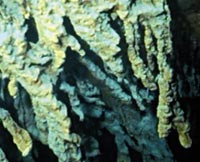
Rusticles on the Titanic
Two interesting stories of shipwrecks in the press recently – the wreck of the Titanic is being consumed by newly identified steel-munching bacteria, while scientists are discovering large numbers of well preserved shipwrecks in the dark and cold Baltic where there are 1,500 confirmed wrecks in Finnish waters, nearly half of which them are more than a century old. Most experts believe the actual number is much higher.
Steel-munching bacteria are devouring the Titanic, say scientists
The newly identified bacteria, isolated from ‘rusticles’ on the Titanic, could also damage vital underwater installations such as offshore oil and gas pipelines.
It may have been an iceberg that sunk the Titanic but it is a bacterium that is slowly destroying its remains on the ocean floor, scientists said today.
Microorganisms collected from a “rusticle” – a structure that looks like an icicle but consists of rust – are slowly destroying the iron hull of the liner on the seabed 3.8km (2.36 miles) below the Atlantic waves where it plummeted, killing 1,517 people, in April 1912.
The newly identified species, while potentially dangerous to vital underwater installations such as offshore oil and gas pipelines, could also offer a new way to recycle iron from old ships and marine structures, according to the researchers from Dalhousie University in Halifax, Canada, and Seville University in Spain.
The discovery of the bacterium, now named Halomonas titanicae, will be reported in the International Journal of Systematic and Evolutionary Microbiologyon Wednesday. When the researchers tested its rusting ability in the lab, they found that it was able to adhere to steel surfaces, creating knob-like mounds of corrosion products.
A thousand shipwrecked stories call from a Baltic seabed
Finland’s coastline is so treacherous that even modern-day sailors must strictly adhere to maps to navigate the labyrinth of islands, shallow water, skerries and rocks that have doomed countless boats over the centuries.
And yet the waters have low levels of corrosive salt, a unique absence of ship-eating worms and very little sunlight, all of which create ideal conditions for preserving sunken wrecks.
There are 1,500 confirmed wrecks in Finnish waters and nearly half of them are more than a century old, according to the Board of Antiquities, but most experts believe the actual number to be much higher.
Alvik says new sightings are reported every year.
“Seeing an intact ship on the bottom of the sea is heart-stopping,” says Rami Kokko, a marine archaeologist who has made countless dives to the bottom of the ocean.
“But the wrecks from the Middle Ages are also intriguing, because even though they are in worse shape, they still hold the pottery and cargo from the era,” he says.
Painstaking research into the ships, their cargo and sometimes the remains of those still trapped inside reveal not only moving personal stories but clues to the life of that era.
Thanks to Irwin Bryan for passing along the article about the Titanic.
